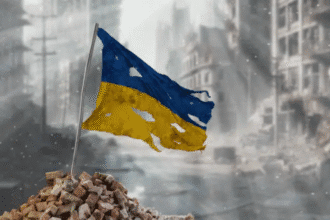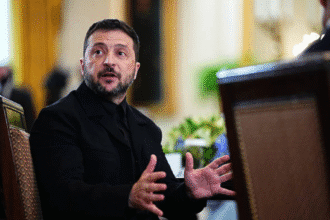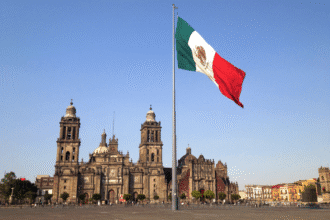Russia has outlined stringent conditions for any prospective Ukraine peace deal, emphasizing the necessity for Ukraine’s neutrality and exclusion from NATO membership. The ongoing war, which began in 2022, has led to devastating losses on both sides. The possibility of a ceasefire remains uncertain as multiple stakeholders, including the United States, NATO, and Ukraine, negotiate terms with Russia. The key challenge lies in finding common ground while addressing security concerns and territorial disputes.
Deputy Foreign Minister Alexander Grushko stated that “ironclad security guarantees” are essential, specifying that Ukraine must adopt a neutral status and that NATO countries must reject its membership aspirations. He further emphasized that Russia would not accept any agreement that did not meet these conditions.
What are the key demands from Russia?
At the heart of Russia’s demands is its insistence that Ukraine remains outside NATO. Russian officials argue that allowing Ukraine into the alliance would pose an existential threat to Russia’s security. Grushko emphasized that only by excluding Ukraine from NATO and preventing the deployment of foreign military contingents on its territory can regional security be assured.
Russia is also demanding recognition of its territorial claims, particularly in Crimea and the Donetsk and Luhansk regions. According to Putin, these territories are now part of Russia, and any Ukraine peace deal must acknowledge this reality. Furthermore, Russia has insisted on restrictions on Ukraine’s military capacity, arguing that a heavily armed Ukraine poses a threat to Russian stability.
Moscow has also called for sanction relief as part of a broader settlement. The Russian economy has suffered under extensive Western sanctions, and any peace negotiations will likely include discussions on easing these measures.
How is the United States responding to the situation?
U.S. President Donald Trump has expressed optimism about advancing peace efforts in Ukraine. He announced plans to discuss the Ukraine peace deal with Russian President Vladimir Putin, stating, “A lot of work’s been done over the weekend. We want to see if we can bring that war to an end.” Trump also mentioned that discussions would encompass topics such as territorial issues and power plants, hinting that resource distribution may play a crucial role in any final agreement.
The United States has played a critical role in supporting Ukraine, providing military aid and diplomatic backing. However, Trump’s approach has been markedly different from his predecessors. He has signaled a willingness to negotiate directly with Putin, even considering potential concessions to secure an end to the war. Some U.S. allies have raised concerns about the implications of such an approach, fearing that it could weaken Ukraine’s position.
What is the proposed ceasefire plan?
The United States and Ukraine have jointly proposed a 30-day ceasefire to Russia. While President Putin has expressed nominal support for this initiative, he has also set forth stringent preconditions, including Ukraine’s recognition of Russia’s annexation of territories, a commitment not to join NATO, and the demilitarization of Ukraine. The Ukraine peace deal remains a complex negotiation with multiple stakeholders, each with competing interests.
Putin has also raised concerns about how a ceasefire could be monitored and enforced along the eastern frontline. Given the history of failed ceasefires in the conflict, Russia has insisted on strict mechanisms to ensure compliance. The Kremlin has proposed the involvement of international observers, but details on their role remain unclear.
Despite the challenges, there is growing international pressure for an immediate ceasefire. Humanitarian organizations have highlighted the devastating toll of the war, with thousands of civilians killed and millions displaced. The United Nations has called for an end to hostilities, warning of a worsening humanitarian crisis if the conflict continues.
What are the challenges in the Kursk region?
The western Kursk region of Russia remains a contentious area, with ongoing battles reported. Ukrainian forces launched a military incursion into this region last August, capturing some territory. President Putin claims that Russian forces have regained control and that Ukrainian troops in the area “have been isolated.”
Military analysts suggest that the situation in Kursk reflects a broader struggle for territorial control. While Ukraine has made gains in certain areas, Russia has responded with counteroffensives, aiming to push Ukrainian forces back. The battle for Kursk underscores the difficulty of achieving a lasting ceasefire, as both sides remain deeply entrenched.
How is Ukraine's leadership reacting?
Ukrainian President Volodymyr Zelensky has accused President Putin of attempting to “sabotage” diplomatic efforts aimed at securing an immediate ceasefire. Despite these accusations, Ukraine has agreed to the U.S.-proposed 30-day ceasefire, increasing pressure on Russia to respond. The Ukraine peace deal continues to evolve as diplomatic efforts intensify.
Zelenskyy has insisted that any peace agreement must respect Ukraine’s territorial integrity and sovereignty. He has rejected calls for Ukraine to give up any land as part of a settlement, arguing that doing so would set a dangerous precedent. “Ukraine will not surrender its land in exchange for a temporary peace,” he stated in a recent speech.
What are the prospects for a peace agreement?
The path to a Ukraine peace deal remains fraught with challenges. Russia’s demands, particularly concerning Ukraine’s NATO aspirations, have been a longstanding point of contention. NATO and the United States have previously rejected such demands, emphasizing the alliance’s open-door policy and the right of countries to choose their security arrangements.
For Ukraine, the stakes are high. A peace deal that concedes too much to Russia could undermine its sovereignty and long-term security. On the other hand, continued conflict carries significant costs, including economic devastation and human suffering.
International mediators, including representatives from Europe and the United Nations, have been working to bridge the gap between the two sides. Some experts suggest that a phased approach may be necessary, with initial agreements focused on humanitarian relief and de-escalation, followed by more comprehensive political negotiations.
The upcoming discussions between Presidents Trump and Putin will be pivotal in determining whether a compromise can be reached to end the ongoing conflict. While a final peace agreement may not be imminent, these talks represent a crucial step toward resolving one of the most significant geopolitical crises of the 21st century.








